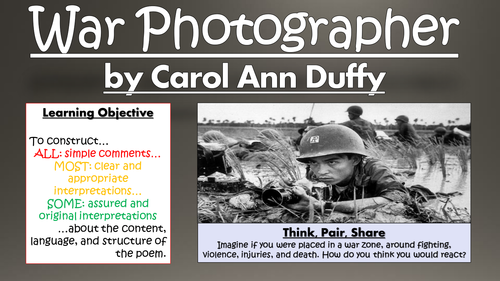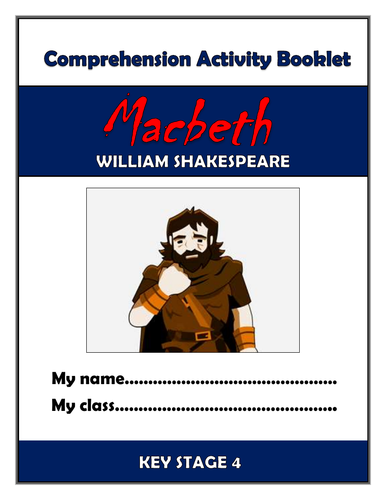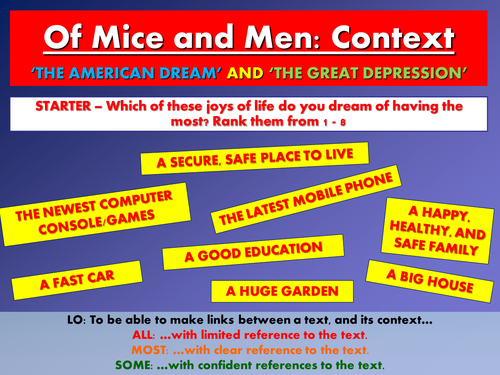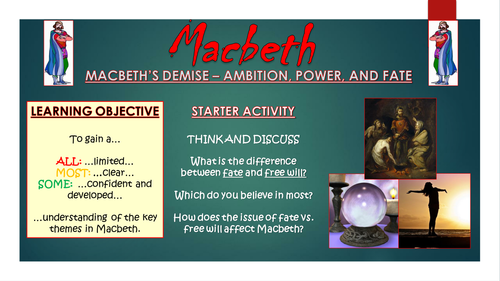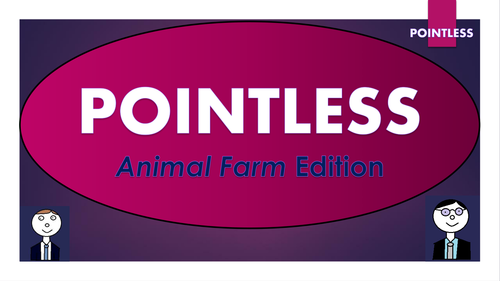
3k+Uploads
1972k+Views
2283k+Downloads
New teachers

A Christmas Carol: The Development of Scrooge!
This engaging and informative lesson enables students to make insightful and developed interpretations regarding the character of Ebenezer Scrooge in ‘A Christmas Carol.’ In particular, they explore how his character is originally introduced, and then developed throughout the appearances of the three ghosts.
The lesson follows a step-by-step learning journey, in which children learn through:
- Reading and understanding the selected extracts to determine the key traits of Scrooge's character at different points in the text;
- Noticing trends in Scrooge's character throughout the text, observing how he has developed from the opening of the text through completion of a 'Character Arc.'
- Analysing Dickens' intentions in developing the character of Scrooge throughout the text;
- Peer assessing each other's learning attempts.
Included is:
- Whole lesson PowerPoint - colourful and comprehensive;
- Selected extracts demonstrating Scrooge's development;
- Character Arc template;
- Analysis template with success criteria for creating well-structured responses;
- Comprehensive lesson plan.
There are also opportunities for group learning, peer assessment, and whole class discussion. This was originally taught to mixed ability year 10 groups, but can easily be differentiated for groups of different ages and abilities.
All images are licensed for commercial use, and image rights are listed on the last page of the presentation.

War Photographer - Carol Ann Duffy
This engaging, comprehensive lesson aims to improve students’ understanding of Carol Ann Duffy’s contemporary war poem ‘War Photographer’ with particular focus upon the language and structure used within the poem to depict the photographer’s experiences. By the end of the lesson, students demonstrate their knowledge of the text analytically, through assured, appropriate, and sustained interpretations.
The lesson follows a step-by-step learning journey, in which children learn through:
- Defining the role of the war photographer, and understanding difficulties in their job;
- Securing contextual understanding of Carol Ann Duffy - the poet;
- Reading and interpreting the poem, using a provided line-by-line analysis, and interactive group activities;
- Developing their understanding through inferring and analysing key language and structural choices;
- Understanding how the war photographer's life varies between war-torn locations and 'Rural England;'
- Analysing how language and structure are used to portray the photographer' experiences;
- Peer assessing each other's learning attempts.
Included is:
- Whole lesson PowerPoint - colourful and substantial; (including hyperlinks to informative and engaging videos)
- Copy of poem;
- Deeper thinking worksheet (including a scaffolded version, and a teacher answer sheet);
- Analysis template with success criteria for creating well-structured responses;
- Comprehensive lesson plan.
There are also opportunities for group learning, peer assessment, and whole class discussion. This was originally taught to middle-ability year 9/10 groups, but can easily be differentiated for groups of different ages and abilities.
All images are licensed for commercial use, and image rights are listed on the last page of the presentation.

Stone Cold - KS3 Comprehension Activities Booklet!
This resource booklet contains a wide range of age-appropriate, engaging, and meaningful comprehension activities for use throughout the reading of Robert Swindells' 'Stone Cold.' Teachers have found them particularly useful in comprehension or guided reading sessions. They are perfect for aiding the progress of children towards meeting the KS3 expectations within the new National Curriculum framework. Children have found these resources engaging, and for teachers there is explicit information within each task regarding which comprehension strands the task is designed to demonstrate. They also relate to key extracts, characters, and themes from the story, ensuring that children gain a deep understanding of the text.
Activities within the booklet include:
- 'Context: Homelessness in London' - to enable students to demonstrate that they can: 'Know the purpose, audience and context of the writing and drawing on this knowledge to support comprehension.'
- 'Swindell's Description' - to enable students to demonstrate that they can: 'Know how language, including figurative language, vocabulary choice, grammar, text structure and organisational features, present meaning.'
- 'Ginger' - to enable students to demonstrate that they can: 'Study setting, plot, and characterisation, and the effects of these.'
- 'Vocabulary Inspector' - to enable students to demonstrate that they can: 'Learn new vocabulary, relating it explicitly to known vocabulary and understanding it with the help of context and dictionaries.'
Plus many, many more activities (the booklet is 21 pages in length!) I've also added it as a PDF in case the formatting differs on your computer.
All images are licensed for commercial use, and are cited on a separate document (included).

An Inspector Calls: Arthur Birling
This interesting and engaging lesson enables students to build their understanding Arthur Birling, one of the chief protagonists in J.B. Priestley’s ‘An Inspector Calls.’ In particular, students learn about his characteristics, his attitudes and opinions towards the world around him and other people, and also his relevance to Priestley’s social and historical context.
The lesson follows a clear, logical, bite-size learning journey, which guides students towards differentiated learning objectives. Over the course of this journey, they become able to:
- Recall and understand the key features of Birling's character profile;
- Link Birling to the social and historical context of the play;
- Understand how Birling's character is significant in terms of Priestley's key message;
- Read and understand the section of the play in which Birling is interviewed by the inspector;
- Analyse key quotations by and about Birling in the text;
- Read and understand the opening of the play;
- Create a diary-entry piece in which they consider Birling's morals and sense of responsibility for the death of Eva Smith;
-Peer/self-assess learning attempts.
This resource pack includes:
- A visually engaging whole-lesson PowerPoint presentation;
- Images of Birling to be annotated for the starter task;
- A clear and interesting worksheet for the introductory task;
- An extract from Act 1 of the play for students to read and interpret;
- P.E.E template for students to complete their character analysis;
- A detailed lesson plan, complete with what the teacher and students should aim to achieve at each stage of the lesson.
All images are licensed for commercial use, and are cited on the final slide of the PowerPoint.

An Inspector Calls: The Context of the Play
These interesting and engaging resources enable students to build their understanding of the context of J.B. Priestley’s play ‘An Inspector Calls.’ In particular, students learn how to make clear and appropriate links between the social and historical context and the play itself. This gives students a really stable knowledge-base from which to make inferences and interpretations about other parts of the play.
The lesson follows a clear, logical, bite-size learning journey, which guides students towards differentiated learning objectives. Over the course of this journey, they become able to:
- Recall the main events that occurred between 1912 and 1945, through an interactive group activity;
- Remember some key information about J.B Priestley and his beliefs;
- Read and understand the opening of the play;
- Make links between the opening of the play and the historical context - both in term of when the play was set, and when it was written;
- Analyse how Priestley links historical context to his characters, in order to get his messages across to the audience;
-Peer/self-assess learning attempts.
This resource pack includes:
- A visually engaging whole-lesson PowerPoint presentation;
- A clear and interesting worksheet for the development task;
- The opening of the text for students to read and interpret;
- Context information cards for the card-sorting game;
- A detailed lesson plan, complete with what the teacher and students should aim to achieve at each stage of the lesson.
All images are licensed for commercial use, and are cited on the final slide of the PowerPoint.

Macbeth Comprehension Activities Booklet!
This resource booklet contains a wide range of age-appropriate, engaging, and meaningful comprehension activities for use throughout the reading of William Shakespeare’s ‘Macbeth.’ Teachers have found them particularly useful in exam revision, comprehension tasks, or guided reading sessions. They are perfect for aiding the progress of students towards meeting the KS4 expectations within the new National Curriculum framework - this makes the tasks suitable for all examining bodies. Students have found these resources extremely engaging, and for teachers there is explicit information within each task regarding which comprehension strands the task is designed to demonstrate. They also relate to key extracts, characters, and themes from the story, ensuring that students gain a deep understanding of the play.
Activities within the booklet include:
- ‘Context: Shakespearean Britain’ - to aid students with ‘Drawing on knowledge of the purpose, audience and context of the writing, including its social, historical and cultural context and the literary tradition to which it belongs, to inform evaluation;’
- ‘Shakespeare’s Description’ - to aid students with ‘Analysing a writer’s choice of vocabulary, form, grammatical and structural features, and evaluating their effectiveness and impact;’
- ‘Lady Macbeth’ - to aid students with ‘Seeking evidence in the text to support a point of view, including justifying inferences with evidence;’
- ‘Editing the Play’ - to aid students with ‘Making an informed personal response, recognising that other responses to a text are possible and evaluating these.’
Plus many, many more activities (the booklet is around 30 pages in length!) I’ve also added it as a PDF in case the formatting differs on your computer.
All images are licensed for commercial use, and are cited on a separate document (included).

Of Mice and Men - Context: The American Dream and The Great Depression
This engaging and interesting lesson aims to improve students' knowledge of the social, historical, and cultural context of John Steinbeck's Of Mice and Men. It also aims to build their skills in creating clear and specific links between the text and it's context, focusing on a specific extract from the novel.
The lesson uses a range of tasks, that require students to use their visual and interactive skills. It follows this learning journey:
- Understanding what dreams are and how they differ for each of us;
- Defining the American Dream, The Wall Street Crash and The Great Depression;
- Creating a timeline which visually depicts the other influential events of the time;
- Reading and reflecting on an extract from the text;
- Analysing the links between texts and contexts, from a success criteria;
- Evaluating each others' analytical attempts.
All images in this resource are licensed for commercial use, and are cited on the final slide of the lesson presentation.
You can choose to buy this resource alone, or as part of the 'Of Mice and Men - All Lessons and Scheme' bundle, which contains seven full lessons, resources, teachers notes, and PowerPoint presentations, plus a Pointless Of Mice and Men game, for just £5!
Bundle Sale

Dr Jekyll and Mr Hyde Huge Bundle!
THIS BUNDLE CONTAINS ALL OF THE DR JEKYLL AND MR HYDE LESSONS, IN ADDITION TO THE COMPREHENSION ACTIVITY BOOKLET, THE KNOWLEDGE ORGANISER AND THE POINTLESS GAME!
This engaging, varied, and informative scheme of learning is designed to help students gain understanding, assessment skills, and key interpretations of Robert Louis Stevenson’s ‘Strange Case of Dr Jekyll and Mr Hyde.’ Made up of a wide-range of interesting and exciting lessons, students should complete this scheme having gathered vital skills in: interpreting the significant meanings of the text, understanding the writer’s ideas within the text, analysing key characters, settings, and themes, and understanding Stevenson’s language devices.
Stimulating, visual, and easily adaptable, these lessons provide suggested learning objectives and outcomes for students of a wide-range of abilities - The vast majority of tasks are differentiated to allow for different abilities and needs in your classroom. Each lesson loosely follows this logical learning journey to ensure that students learn in bite-size steps:
- Engaging
- Defining/ Understanding
- Identifying/Remembering
- Analysing/ Creating
- Peer or self evaluating.
All of the lessons are interactive, employ a variety of different teaching and learning methods and styles, and are visually-engaging. Resources, worksheets, and lesson plans are all provided.
Bundle Sale

AQA Power and Conflict Poetry Huge Bundle!
This bundle contains each of the engaging lessons on poems from the AQA ‘Power and Conflict’ anthology, in addition to the detailed and hugely popular knowledge organisers/ revision mats, and the 16-page comprehension activity booklets, for the poems:
Ozymandias - Percy Bysshe Shelley
Charge of the Light Brigade - Alfred, Lord Tennyson
Exposure - Wilfred Owen
Bayonet Charge - Ted Hughes
War Photographer - Carol Ann Duffy
Poppies - Jane Weir
In addition to this, the lesson on comparing poems is also included - essential for exam technique!
Students will vital skills in: interpreting the significant meanings poems, understanding the writer’s ideas within poems, understanding the social and historical contexts of poems, and analysing features of content, language, and structure.
Stimulating, visual, and easily adaptable, these lessons provide suggested learning objectives and outcomes for students of a wide-range of abilities - The vast majority of tasks are differentiated to allow for different abilities and needs in your classroom. Each lesson loosely follows this logical learning journey to ensure that students learn in bite-size steps:
Engaging
Defining/ Understanding
Identifying/Remembering
Analysing/ Creating
Peer or self evaluating.
All of the lessons are interactive, employ a variety of different teaching and learning methods and styles, and are visually-engaging. Resources, worksheets, and lesson plans are all provided.

A View from the Bridge: Greek Tragedy - Eddie's Downfall!
This interesting and highly-stimulating lesson students to demonstrate a developed, sustained understanding of the structural features of the Greek Tragedy which are utilised in Arthur Miller’s A View from the Bridge. In particular, students engage analytically with Eddie’s ‘hamartia’ and catastrophic downfall at the end of Act II. Students examine how Eddie’s role as a tragic hero, his fatal flaw, and the sense of fate which runs throughout, mirrors the features of Greek Tragedies.
The lesson follows a clear, logical, bite-size learning journey, which guides students towards differentiated learning objectives. Over the course of this journey, they become able to:
- Define and identify the features of Greek Tragedies;
- Understand Miller's views towards Greek Tragedies, and his intentions for writing the play in this form;
- Identify the features of Greek Tragedy in A View from the Bridge;
- Critically engage with text as a Greek Tragedy, considering how Eddie's downfall is constructed by his fatal flaws, hamartia, and catastrophe;
-Peer assess each other's learning attempts.
This resource pack includes:
- A visually engaging whole-lesson PowerPoint presentation;;
- Paper copies and online links to the extract needed for the lesson (end section of Act Two);
- Greek Myths Definitions Cards;
- Greek Myths worksheet (including answer sheet for teachers);
- A logically scaffolded essay template;
- A detailed lesson plan, complete with what the teacher and students should aim to achieve at each stage of the lesson.
All images are licensed for commercial use, and are cited on the final slide of the PowerPoint.

Out of the Blue - Simon Armitage - 9/11 Poem
These informative and engaging resources enable students to build the skills needed to interpret and analyse the langauge used in poems. These resources also give students a strong foundation knowledge, including the SMSC implications, of the events of 9/11 - an important historical day that should never be forgotten.
Students learn through the following tasks:
- Collecting and discussing knowledge of the events of the day through an interactive starter task;
- Reading the poem 'Out of the Blue' and identifying the descriptive devices throughout the poem;
- Discussing a model analytical paragraph about the language used in the poem, in order to form their own success criteria;
- Using a template to form their own analytical paragraphs about the language used in the poem;
- Using peer or self-assessment in order to establish their success at analysing language.
The following resources are provided:
- Engaging and colourful step-by-step PowerPoint
- Poem
- Teacher lesson guidance;
- Identifying worksheet;
- Analysis template;
- Writing to analyse help-sheet
- Analysis model
All images are licensed for commercial use, and are cited on the final slide of the PowerPoint.

An Inspector Calls: Priestley's Dramatic Devices
This interesting and engaging lesson enables students to build their understanding of the dramatic devices employed by J.B. Priestley throughout the play ‘An Inspector Calls.’ In particular, students learn how to make sustained, clear interpretations about the impact of the dramatic devices upon tone, plot, and meaning. They also contemplate how Priestley utilises dramatic devices to communicate his underlying messages about responsibility and social duty to his audience.
The lesson follows a clear, logical, bite-size learning journey, which guides students towards differentiated learning objectives. Over the course of this journey, they become able to:
- Define and understand key dramatic devices;
- Identify and discuss the dramatic devices that Priestley uses towards the end of Act One.;
- Read and interpret the end section of Act One in the play;
- Analyse how Priestley's use of dramatic devices is used effectively for impact;
-Peer/self-assess learning attempts.
This resource pack includes:
- A visually engaging, comprehensive whole-lesson PowerPoint presentation;
- The end of Act 1 extract of the text for students to read and interpret (with a pre-highlighted example for the identification task);
- Dramatic Devices information cards for the card-sorting game;
- A scaffolded template for the main analytical task, with a further completed model example.
- A detailed lesson plan, complete with what the teacher and students should aim to achieve at each stage of the lesson.
All images are licensed for commercial use, and are cited on the final slide of the PowerPoint.

The Five Oceans - Knowledge Organiser!
This clear, detailed and visually-appealing resource offers a complete reference point for students revising knowledge relating to the five oceans, as a part of their study of locational knowledge in geography. It contains comprehensive sections on:
Overview and world map;
The Five Oceans Facts;
The Five Oceans by Size;
Deepest Points in the Oceans;
Interesting Ocean Features;
Top Ten Ocean Facts.
The resource is designed to be printed onto A3, and is provided as both a PDF and a Word version (so that you can edit if you want to). All images used are licensed for commercial use and are cited on a separate document (included). The resource is most suitable for students in KS1 or KS2.

Macbeth: The Demise of Macbeth - Ambition, Power, and Fate
This lesson aims to improve students’ understanding of the key themes throughout William Shakespeare’s ‘Macbeth:’ ambition, power, and fate. In particular, students learn how the combination of these three ideas contribute to Macbeth’s eventual downfall, whilst drawing on their analytical reading skills to understand how the themes interweave with the plot throughout the play.
The lesson utilises a range of tasks, that require students to be visual and interactive learners. It follows this learning journey:
- Defining the key terms 'fate' and 'free will', and establishing their relevance within the play;
- Reading and interpreting Act 5 Scene 8, and establishing how Macbeth's death was set in motion long before the battlefield;
- Mapping Macbeth's demise, from his early success as a brave and respected warrior, to his death as a tyrant king;
- Understanding and analysing how the key themes of ambition, power, and his belief in fate contributed to his downfall;
- Peer/self evaluating the learning in the lesson.
Included in this resource pack are:
- A well-presented, thorough, and informative, whole-lesson PowerPoint presentation;
- Resources for the reading and interpreting activity - full scene transcript with space for notes;
- A template and instructions for the 'Mood Mapping' task;
- A template to help scaffold the main task, complete with P.E.E instructions;
- A comprehensive teacher guidance form/lesson plan to assist delivery.
All images in this resource are licensed for commercial use, and are cited on the final slide of the lesson presentation.
Bundle Sale

Macbeth Huge Bundle!
THIS BUNDLE CONTAINS ALL OF THE MACBETH LESSONS, IN ADDITION TO THE COMPREHENSION ACTIVITY BOOKLET, THE MACBETH KNOWLEDGE ORGANISER, AND THE POINTLESS GAME!
This engaging, varied, and informative scheme of learning is designed to help students gain understanding, assessment skills, and key interpretations of William Shakespeare’s ‘Macbeth.’ Made up of a wide-range of interesting and exciting lessons, students should complete this scheme having gathered vital skills in: interpreting the significant meanings of the text, understanding the writer’s ideas within the text, analysing key characters, settings, and themes, and understanding Shakespeare’s language devices.
Stimulating, visual, and easily adaptable, these lessons provide suggested learning objectives and outcomes for students of a wide-range of abilities - The vast majority of tasks are differentiated to allow for different abilities and needs in your classroom. Each lesson loosely follows this logical learning journey to ensure that students learn in bite-size steps:
- Engaging
- Defining/ Understanding
- Identifying/Remembering
- Analysing/ Creating
- Peer or self evaluating.
All of the lessons are interactive, employ a variety of different teaching and learning methods and styles, and are visually-engaging. Resources, worksheets, and lesson plans are all provided.
Bundle Sale

A Christmas Carol Huge Bundle!
THIS BUNDLE CONTAINS ALL OF THE ‘A CHRISTMAS CAROL’ LESSONS, IN ADDITION TO THE 30-PAGE COMPREHENSION BOOKLET, THE KNOWLEDGE ORGANISER, AND THE POINTLESS GAME!
This engaging, varied, and informative scheme of learning is designed to help students gain understanding, assessment skills, and key interpretations of Charles Dickens’ A Christmas Carol. Made up of a wide-range of interesting and exciting lessons, students should complete this scheme having gathered vital skills in: interpreting the significant meanings of the text, understanding the writer’s ideas within the text, analysing key characters, settings, and themes, and understanding Dickens’ language devices.
Stimulating, visual, and easily adaptable, these lessons provide suggested learning objectives and outcomes for students of a wide-range of abilities - The vast majority of tasks are differentiated to allow for different abilities and needs in your classroom. Each lesson loosely follows this logical learning journey to ensure that students learn in bite-size steps:
- Engaging
- Defining/ Understanding
- Identifying/Remembering
- Analysing/ Creating
- Peer or self evaluating.
All of the lessons are interactive, employ a variety of different teaching and learning methods and styles, and are visually-engaging. Resources, worksheets, and lesson plans are all provided.
Bundle Sale

Tudor Monarchs - Knowledge Organisers Bundle!
These clear, detailed and visually-appealing resource offers a complete reference point for children learning about each of the Tudor monarchs. Included are knowledge organisers for each of the following Tudor monarchs:
-Henry VII
-Henry VIII
-Edward VI
-Mary I
-Elizabeth I
Each knowledge organiser contains comprehensive sections based on the following categories:
Overview;
Times in His/Her Life;
Important Vocabulary;
Timeline of Important Events;
Answers to the Important Questions;
Top Ten Facts.
The resources are most suitable for children in either upper KS2 or KS3. designed to be printed onto either A4 or A3, and are provided as both a PDF and a Word version (so that you can edit if you want to). All images used are licensed for commercial use.

Travel Writing: Constructing Imaginative Language
This engaging and stimulating lesson enables students to create travel writing texts containing appropriate and imaginative language choices, utilising a range of different language techniques with subtlety in order to craft vivid and thought-provoking writing. In particular, students learn how the subtle use of varied verbs, adverbs, and adjectives, in addition to descriptive devices such as similes, metaphors, and personification, can help to create truly authentic and descriptive travel writing pieces.
The lesson follows a clear, logical, bite-size learning journey, which guides students towards differentiated learning objectives. Over the course of this journey, they become able to:
- Define and identify verbs, adverbs, and adjectives, and understand the effects of varying these basic sentence building blocks;
- Employ appropriate and imaginative verbs, adverbs, and adjectives to describe a range of travel images;
- Understand and analyse how more advanced descriptive devices (similes, metaphors, personification, alliteration, and assonance) influence the effect of writing;
- Analyse a model travel writing attempt in relation to language features, before creating their own;
- Self/Peer assess travel writing attempts.
This resource pack includes:
- A visually engaging whole-lesson PowerPoint presentation;
- An interesting and ambitious travel writing extract (with a highlighted version for teachers):
-A logical and challenging worksheet, encouraging students to identify and analyse;
- A detailed lesson plan, complete with what the teacher and students should aim to achieve at each stage of the lesson.
All images are licensed for commercial use, and are cited on the final slide of the PowerPoint.

Pupil Progress Performance Grids
For use alongside data captures and discussions about pupil progress, this succinct performance grid enables observers to gauge and categorise department and individual teacher approaches to pupil progress data, using OFSTED guidance. The first page of the document provides descriptors of 'outstanding', 'good', 'requires improvement' and 'inadequate' feedback within appropriately considered focus areas, for example: Rate of Progress, Accuracy, Noticing Trends and Plotting Interventions, etc. Schools that already employ this tool often opt to highlight the descriptors on this page as they complete the scrutiny, thus creating a bigger picture of the strengths and areas for improvement observed. This can also be a helpful aid in arriving at an overall judgement, should your school opt to arrive at one. The second page allows observers to further pinpoint and describe the 'www' (what went well) and 'ebi' (even better if) aspects of the feedback, to aid teacher/department in improving their practice.

Animal Farm Pointless Game! (and blank template to create your own games!)
Based on the popular game show 'Pointless', this resource is perfect for use as a whole lesson resource, enrichment option, or revision tool. Editable, so that you can change to any other topic or change questions. (I've also added a blank template so that you can make your own games from scratch). Containing almost 30 slides of sound clips, interesting tasks, and suitably challenging questions, this resource is effective at both promoting engagement and enhancing learning. There are several full rounds of questions to build or revisit knowledge of characters, plot, and themes in 'Animal Farm.'
Round 1. The characters in Animal Farm
Round 2. Quotations from the text
Round 3. Settings and Objects
Round 4. Themes in Animal Farm
The nature of this game ensures that the resource can challenge students of all levels.
A blank template has also been added, so that you can create your own games!


